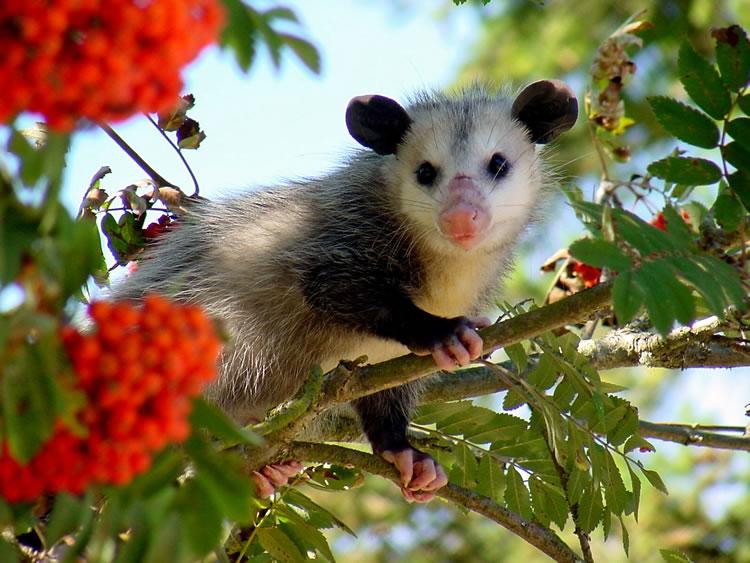Opossums are inhibited animals, especially in daylight or under artificial light, but are by no means stupid. Results from some learning and discrimination tests rank opossums above dogs and more or less on a par with pigs in intelligence.
Description and Range
Physical description
Opossums are marsupials (mammals with a pouch in which they carry their young), a primitive group of mammals found most commonly in Australia. Kangaroos, koalas, and wombats are other well known marsupials. Opossums are the only marsupials in North America. All other mammals are placentals, which means their young develop within a saclike membrane called the placenta inside the mother’s uterus, rather than in an exterior pouch.
Geographic range
Opossums have adapted well to living close to people in urban and suburban environments. Except for higher elevations, opossums now occupy most human-occupied habitats in western Washington. Prior to European settlement of North America, the opossum was found only in Central America and the southeastern United States. During the 1900s, its range expanded northward and westward. Virginia opossums, also known as “possums,” first arrived in Washington in the early 1900s as pets and novelties. Some of these animals, or their offspring, later escaped from captivity or were intentionally released.
Living with wildlife
Viewing Opossums
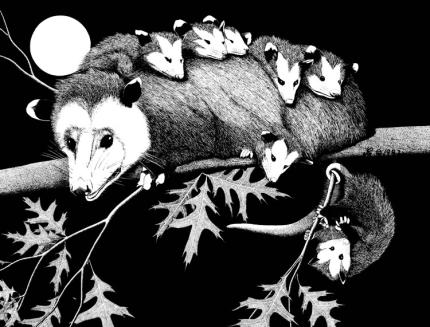
Opossums are nocturnal, spending the day in dens or other protected spots. However, they can be seen at any time of day, especially in winter when food is scarce. At night, opossums forage in areas near their current dens, but can travel up to 2 miles in search of food.
Opossums are solitary animals, and except during breeding season or a female with her young, they are rarely seen together. Opossums do not hibernate.
Although they can climb and are good swimmers, opossums prefer to amble about on the ground. With a top speed of about 4 miles per hour, when “running,” opossums appear to be walking quickly, with the tail rotating in circles for balance. When idle, opossums constantly groom themselves, much as house cats do.
A nighttime walk along a path bordering a stream or wetland, or down an alley lined with trashcans, will occasionally turn up an opossum searching for food. Strong but not agile climbers, opossums can be observed climbing trees to escape, search for food, rest, or to look for dens. Their tails are able to wrap around and grasp tree limbs and can support the animal’s full weight for short periods. (Contrary to myth, opossums do not hang upside down by their tails when sleeping.)
Trails
Opossums readily use trails made by other wildlife or humans near creeks, ravines, and wetlands. Like raccoons and foxes, opossums use culverts as a safe way to cross under highways and roadways. In developed areas, trails occur along buildings and fences. Wear marks and hairs may be found around the edges of entry points where opossums are entering a building or crawling under a fence. Opossum hair is long and silver to gray in color.
Tracks
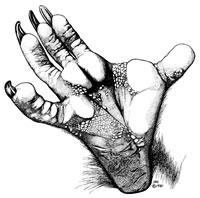
Tracks can be found in mud, snow, or fine soil; also on deck railings, downspouts, and other surfaces that opossums use to gain access to structures (Fig. 3). The opossum’s opposable hind thumbs create a unique print, pointing as much as 90 degrees away from the direction of travel.
Droppings
Opossum droppings are not easily found, but can be seen along trails they use and near favorite feeding spots. Opossum droppings vary in appearance according to the animal’s diet and may resemble the droppings of house cats and small domestic dogs, coyotes, and foxes (Fig. 4). Firm droppings are pointed on the ends and 1 to 3 inches long.
Calls
Opossums are among the most silent animals that live in Washington, but when frightened or threatened they growl and hiss.
Playing Possum
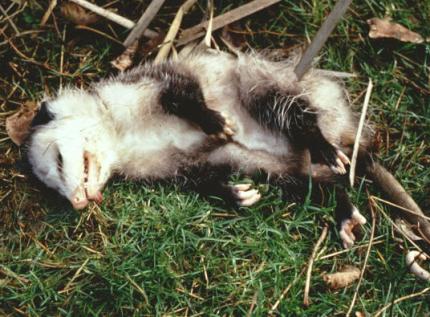
The opossum is a slow runner and when threatened will usually growl, hiss, and bare its teeth or try to escape by climbing the nearest tree. However, when caught out in the daylight with little chance of escape, or when attacked, the opossum will “play possum.” This is a surprisingly effective defense commonly seen in insects. In such cases the opossum will fall on its side, curl its body, open its drooling mouth, and excrete droppings—all to give the appearance of being dead.
While the opossum is in this state, which lasts several minutes or several hours, no amount of prodding will produce a response. Though it appears to be in a catatonic state, its metabolic processes are as high as when the animal is fully alert.
When the opossum believes the danger has passed, it will begin to wiggle its ears in an effort to pick up sounds. If it thinks the danger has passed, it will pick up its head and look around. If danger persists, the opossum will play dead again.
Preventing conflict
In urban areas, opossums are beneficial as rodent and carrion eaters. They also clean up uneaten food that might otherwise attract mice and rats. However, in rural areas the impact of non-native opossums preying upon native invertebrates, small mammals, amphibians, reptiles, ground-nesting birds, nestlings, and eggs is of concern to wildlife biologists.
As long as they are kept out of human homes, not cornered, and their interaction with pets is limited, opossums are not dangerous. If an opossum finds its way into your house, stay calm, close surrounding interior doors, leave the room, and let the animal find its own way out through the pet door or an open door or window. If necessary, gently use a broom to coral the opossum outside. Do not corner an opossum, thereby forcing it to defend itself.
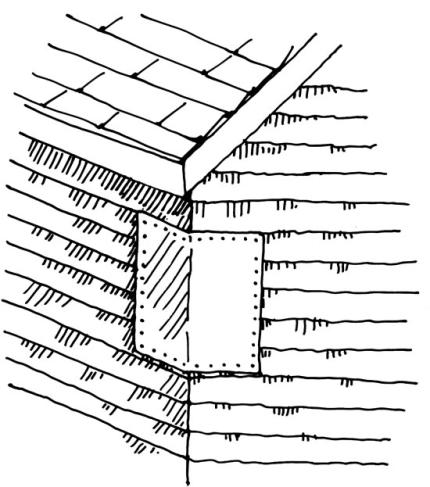
An opossum’s search for food may lead it to a vegetable garden, garbage can, or chicken coop. Its search for a den site may lead it to an attic, chimney, or crawl space. The most effective way to prevent conflicts is to modify the habitat around your home so as not to attract opossums.
Don’t feed opossums. Feeding opossums may create undesirable situations for you, your children, neighbors, pets, and the opossums themselves. Opossums that are fed by people often lose their fear of humans and may become aggressive when not fed as expected. Artificial feeding also tends to concentrate opossums in a small area; overcrowding can spread diseases and parasites. Finally, these hungry visitors might approach a neighbor who doesn’t share your appreciation of the animals. The neighbor might choose to remove these opossums, or have them removed.
Don’t give opossums access to garbage. Keep your garbage can lid on tight by securing it with rope, chain, bungee cords, or weights. Better yet, buy garbage cans with clamps or other mechanisms that hold lids on. To prevent tipping, secure side handles to metal or wooden stakes driven into the ground. Or keep your cans in tight-fitting bins, a shed, or a garage. Put garbage cans out for pickup in the morning, after opossums have returned to their resting areas.
Feed dogs and cats indoors and keep them in at night. If you must feed your pets outside, do so in late morning or at midday, and pick up food, water bowls, leftovers, and spilled food well before dark every day.
Keep pets indoors at night. If cornered, opossums may attack dogs and cats. Bite wounds from opossums can result in fractures and disease transmission.
Prevent opossums from entering pet doors. Keep indoor pet food and any other food away from a pet door. Lock the pet door at night. If it is necessary to have it remain open, put an electronically activated opener on your pet’s collar. Note: Floodlights or motion detector lights placed above the pet door to scare opossums are not long-term solutions.
Put food in secure compost containers and clean up barbecue areas. Don’t put food of any kind in open compost piles; instead, use a securely covered compost structure or a commercially available opossums-proof composter to prevent attracting opossums and getting exposed to their droppings. A covered worm box is another alternative. If burying food scraps, cover them with at least 8 inches of soil and don’t leave any garbage above ground in the area—including the stinky shovel. Cover the burial site with heavy wire mesh and a weight as further prevention. Clean barbecue grills and grease traps thoroughly following each use.
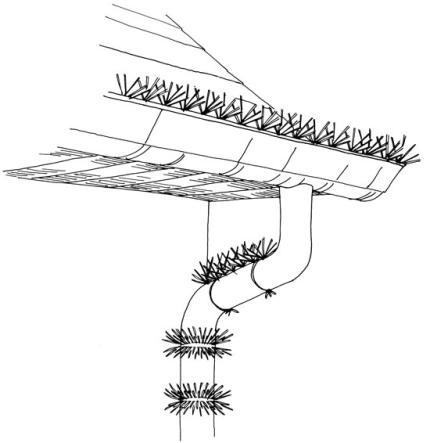
Eliminate access to denning sites. Opossums commonly use chimneys, attics, and spaces under houses, porches, and sheds as den sites. Close any potential entries with ¼-inch mesh hardware cloth, boards, or metal flashing. Make all connections flush and secure to keep mice, rats, and other mammals out. Make sure you don’t trap an animal inside when you seal off a potential entry (see “Opossums in or Under Buildings” the handout Evicting Animals from Buildings for additional information).
Install a commercially designed and engineered chimney cap (homemade caps are often unsafe and may be a fire hazard). You can still have fires in your fireplace; however, the “cap” will keep opossums and other wildlife out. (For information on how to remove opossums from chimneys, see “Raccoons in Dumpsters and Down Chimneys” in the handout on Raccoons.)
Prevent opossums from accessing rooftops by trimming tree limbs away from structures and by attaching sheets of metal flashing around corners of buildings (Fig. 7). Commercial products that prevent climbing are available from farm supply centers and bird-control supply companies on the Internet (Fig. 8). Remove vegetation on buildings, such as English ivy, which provide opossums a way to climb structures and hide their access point inside.
Trapping Opossums
Trapping and relocating an opossum several miles away seems an appealing method of resolving a conflict because it is perceived as giving the animal a second chance in a new home. Unfortunately, in addition to being illegal (see “ Legal Status ”), moving opossums often will not solve the original problem because other opossums will replace them and cause similar conflicts. Hence, it is more effective to make the site less attractive to opossums than it is to routinely trap them.
It is legal to trap an opossum, and then release the animal at the site of capture. With this option, the opossum is trapped and released on site after its reentry into a structure is prevented by physical exclusion. (See “ Opossums in or Under Buildings ” for exclusion techniques.)
In such a case, the opossum is evicted within its home range and because it is familiar with its surroundings, it can soon find suitable food and shelter. In the event young are present but were not noticed prior to trapping, allow the female back inside to tend to her dependent offspring.
A downside to this approach is the possibility that the animal may simply enter someone else’s attic, chimney, or similar place. Then, if someone else has to trap the animal, they will be dealing with a trap-smart opossum, making its capture difficult.
If an opossum needs to be trapped, use a single- or double-door type live trap that measures 11 x 11 x 36 inches. Bait with cracked boiled eggs, sliced apples or other fruit, or vegetables to prevent attracting cats or small dogs. Place the trap where the animal, or evidence of the animal has been seen.
Public Health Concerns
Although opossums might carry several diseases of significance to humans, their role in the transmission of any of these diseases is uncertain. Anyone handling a dead or live opossum should wear rubber gloves, and wash his or her hands well when finished.
There is convincing evidence that the parasite that causes Equine Protozoal Myeloencephalitis (EPM), a disease in horses, is carried by the opossum. EPM is an infection of the central nervous system; the neurologic signs that are most apparent in horses include dizziness, weakness, and spasticity.
While there are no guaranteed methods of preventing exposure to this parasitic organism, horse owners can minimize risks by making facilities less attractive to opossums. Remove or seal up food that opossums might find attractive, such as cat food left out, grain sitting in buckets, feed in uncovered bins, and garbage in open cans. If feed has been left exposed, check it for droppings before serving it to your horses.
Droppings need not be fresh to be dangerous; the parasite can live outside a host and remain potentially infectious for as long as one year.
The rabies virus does not exist in Washington opossum populations, and for some unknown reason opossums rarely get rabies elsewhere.
If a person is bitten or scratched, immediately clean the wound by thoroughly scrubbing it with soap and water. Flush the wound liberally. A physician should examine all wounds caused by an opossum.
Legal Status
The opossum is unclassified and may be trapped or killed year-round; no permit is necessary. No permit is necessary for the use of live (cage) traps; however, a special trapping permit is required for the use of all traps other than live traps ( RCW 77.15.192 , 77.15.194 ; WAC 220-417-040).
It is unlawful to release an opossum anywhere within the state, other than on the property where it was legally trapped, without a permit to do so ( RCW 77.15.250 ; WAC 220-450-010). Except for bona fide public or private zoological parks, persons and entities are prohibited from importing opossums into the state without a permit to do so ( WAC 246-100-191 ).
Because legal status, trapping restrictions, and other information about opossums change, contact your local Fish and Wildlife office for updates.
